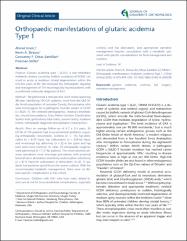| dc.contributor.author | İmerci, Ahmet | |
| dc.contributor.author | Strauss, Kevin A | |
| dc.contributor.author | Oleas-Santillan, Geovanny F | |
| dc.contributor.author | Miller, Freeman | |
| dc.date.accessioned | 2020-11-20T14:29:59Z | |
| dc.date.available | 2020-11-20T14:29:59Z | |
| dc.date.issued | 2020 | |
| dc.identifier.issn | 1863-2521 | |
| dc.identifier.issn | 1863-2548 | |
| dc.identifier.uri | https://doi.org/10.1302/1863-2548.14.200059 | |
| dc.identifier.uri | https://hdl.handle.net/20.500.12809/299 | |
| dc.description | WOS: 000581117600015 | en_US |
| dc.description.abstract | Purpose: Glutaric acidemia type 1 (GA1), a rare hereditary metabolic disease caused by biallelic mutations of GCDH, can result in acute or insidious striatal degeneration within the first few years of life. We reviewed the orthopaedic sequelae and management of 114 neurologically injured patients with a confirmed molecular diagnosis of GA1. Methods: We performed a retrospective chart review spanning 28 years identifying 114 GA1 patients, most from the Old Order Amish population of Lancaster County, Pennsylvania, who were homozygous for a pathogenic founder variant of GCDH (c.1262C>T). We collected demographics, medical comorbidities, muscle tone patterns, Gross Motor Function Classification System level, gastrostomy tube status, seizure history, inpatient events, orthopaedic diagnoses and operative characteristics. Results: Over an average follow-up of 4.7 +/- 3.4 years, 24 (21%) of 114 patients had musculoskeletal problems requiring orthopaedic consultation. Scoliosis (n = 14), hip dislocation (n = 8/15 hips), hip subluxation (n = 2/three hips), and windswept hip deformity (n = 2) in the spine and hip joint were most common. In total, 35 orthopaedic surgeries were performed in 17 (71%) patients. The most common primary operations were one-stage procedures with proximal femoral varus derotation osteotomy and/or pelvic osteotomy (n = 8/14 hips) for subluxation or dislocation. In all, 11 patients had posterior spinal fusion for severe scoliosis. With the recommended metabolic management, there were no disease-specific complications in this cohort. Conclusions: Children with GA1 who have static striatal lesions are at risk for musculoskeletal complications, especially scoliosis and hip dislocation, and appropriate operative management requires consultation with a metabolic specialist with specific considerations for fluid management and nutrition. Level of Evidence: IV | en_US |
| dc.item-language.iso | eng | en_US |
| dc.publisher | British Editorial Soc Bone & Joint Surgery | en_US |
| dc.item-rights | info:eu-repo/semantics/openAccess | en_US |
| dc.subject | Glutaric Acidemia | en_US |
| dc.subject | Scoliosis | en_US |
| dc.subject | Hip Surgery | en_US |
| dc.subject | Operative Management | en_US |
| dc.title | Orthopaedic manifestations of glutaric acidemia Type 1 | en_US |
| dc.item-type | article | en_US |
| dc.contributor.department | MÜ, Tıp Fakültesi, Cerrahi Tıp Bilimleri Bölümü | en_US |
| dc.contributor.institutionauthor | İmerci, Ahmet | |
| dc.identifier.doi | 10.1302/1863-2548.14.200059 | |
| dc.identifier.volume | 14 | en_US |
| dc.identifier.issue | 5 | en_US |
| dc.identifier.startpage | 473 | en_US |
| dc.identifier.endpage | 479 | en_US |
| dc.relation.journal | Journal of Childrens Orthopaedics | en_US |
| dc.relation.publicationcategory | Makale - Uluslararası Hakemli Dergi - Kurum Öğretim Elemanı | en_US |


















